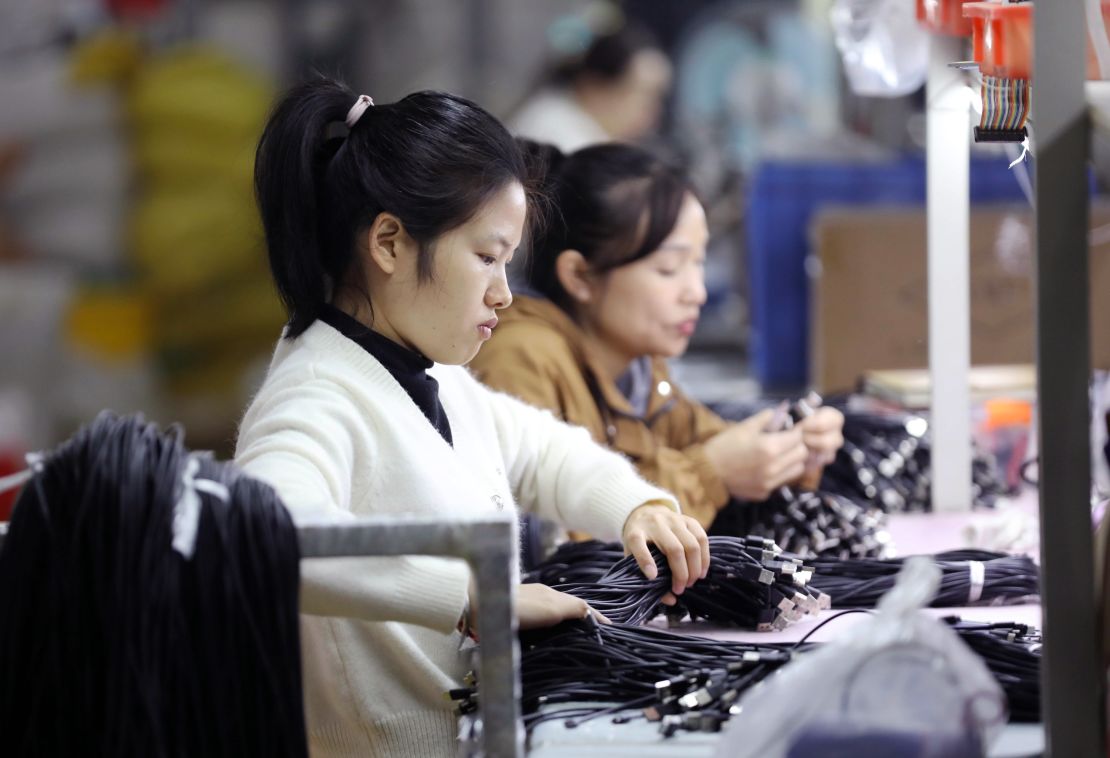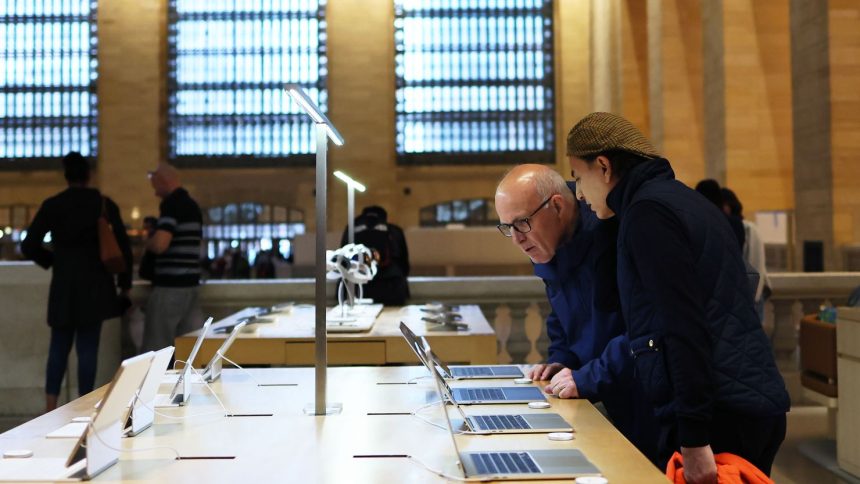New York
CNN
—
Those shopping for a new smartphone or computer may be spared from tariff-induced sticker shock. At least, for now.
President Donald Trump issued a memorandum on April 11 saying certain electronics — including computers, smartphones and some components — won’t be subject to the reciprocal tariffs imposed on imports from China. While tariffs on virtually all other products from China are now at least 145%, prices of smartphones and certain other devices should avoid completely skyrocketing, at least for a little while.
But with comments from the Trump administration indicating an upcoming wave of tariffs on semiconductors — a critical part of the chips that power electronic devices — it’s still unclear if and when tech products could get more expensive in the US. Plus, the current exclusions aren’t expected to cover many everyday tech products that consumers are likely to buy more frequently than new phones — such as some charging cables and earbuds.
That makes it challenging for shoppers to know what to expect, but also for tech companies to adjust their supply chains and shipments as demand potentially fluctuates due to tariff-induced price swings — all while keeping prices reasonable.
“It’s completely impossible for any company to plan,” said Francisco Jeronimo, vice president of client devices for the International Data Corporation, a firm that tracks global shipments of tech devices. “So the best, the only thing they can do at the moment is… ship as many products as they can while the exemption lasts to the US.”
Some reports indicate that companies may be doing just that. Apple’s India-based suppliers shipped a record number of iPhones to the US in March, nearly $2 billion worth, according to Reuters. PC shipments grew by 12.6% in the US during the first quarter of 2025 as vendors increased shipments ahead of potential tariffs, market research firm Gartner said in a press release Monday.
‘No tariff exception’
The exception is a major win for Apple, which relies on iPhone sales for most of its revenue — about $69 billion of its roughly $124 billion in its first fiscal quarter of 2025 — and has much of its smartphone supply chain located in China. But the Trump administration has indicated that more tech tariffs are coming.
Trump wrote in a Truth Social post on Sunday that “NOBODY is getting ‘off the hook,’” when it comes to tariffs, adding that “there was no tariff exception” announced and these products are still subject to a 20% tariff on Chinese imports.
The excepted products will be moved to a “different tariff bucket” as the administration examines the “whole electronics supply chain,” the post said. The Trump administration on Monday began investigating semiconductor imports to set the stage for tariffs.
Kevin Hassett, national economic council director, said when speaking with CNN’s Jake Tapper on Sunday that “it was always the case” that semiconductors would be covered under a separate action rather than reciprocal tariffs.
The exception came after Trump’s tariff policies resulted in a whirlwind couple of weeks for the stock market, with the S&P 500 having its worst week since 2020 earlier this month.
But the stock market saw massive gains last week when Trump announced a 90-day pause on most reciprocal tariffs, a sign that investors were seeking a reprieve from his levies.
The tech products that are — and aren’t — excepted
The exclusions specifically mention smartphones, computers (described as “automatic data processing machines”), monitors, storage devices and various components that power those devices, including integrated circuits and transistors.
But a host of other tech products don’t appear to be included in the exceptions, such as USB charging cables, portable battery packs, headphones and video game consoles, a public affairs officer for the US International Trade Commission said in response to a CNN inquiry about whether these products fall under the exceptions.
But it’ll likely depend on which components are inside these devices and how they’re categorized.

The US ITC also said computer mice and keyboards are covered under the exceptions, but added that US Customs and Border Protection has the final say on how imported goods are classified and whether they’re exempted from tariffs.
“It’s a gray area,” said Dave Marcotte, a senior vice president and analyst with market research and consultancy firm Kantar. “This is where you get creative about describing your products when you move to Customs. If you look at the scheduling and say, ‘Okay, well, I have, I have peripherals. Are peripherals covered? Or (are) computer cables covered?’ Well, they’re the same thing.”
Even before Trump specified these exclusions, some analysts had expected smaller items like charging cables and headphones to be among those most heavily impacted by tariffs.
“I think the first things you’re going to see (are) the stuff we don’t really pay attention to, like… USB chargers and batteries and stuff that’s less than, say, $20, $25,” Marcotte said last week ahead of Trump’s exception on smartphones and other select tech products. “It’s going to be the small stuff.”
Smaller companies don’t have the supply chain flexibility of a stalwart like Apple, for example, and the margins on cheaper items such as charging cables are much lower. That means these firms don’t have as much flexibility to absorb additional tariff costs and would likely have to pass it down to consumers to turn a profit.
And many of these ancillary tech gadgets appear to be from China.
When CNN searched Amazon for earbuds under $50, iPhone charging cables and portable battery packs, many of the top five results for each product either had China listed as the country of origin, or mentioned a manufacturer based in China. Some of the results didn’t name a country of origin, but other product pages from the same sellers listed products as coming from China.
Trump also got rid of the “de minimis exemption,” which allowed packages valued at less than $800 to enter the US tax-free — another change that’s expected to impact the prices cheap goods from China.
Price hikes on these smaller, cheaper items could feel more impactful to consumers in some cases since the difference in price may feel more drastic.
“A $40 increase to an $80 increase looks a lot worse for a consumer than, say, a $1,200 to $1,500,” said Jack Leathem, an analyst at market research firm Canalys.
What’s happens next
Although some tech products got a break on certain reciprocal levies, new tariffs on semiconductors are expected to arrive in the “next month or two,” Commerce Secretary Howard Lutnick told ABC News on Sunday. It’s part of the Trump administration’s broader effort to reduce US reliance on China while reshoring manufacturing.
But tariffs or not, the chances of an American-made iPhone seem slim. White House press secretary Karoline Leavitt said Trump believes iPhone production could move to the US, but higher labor costs and the logistics of shifting Apple’s massive production network to the other side of the world — further away from Asia, where many components would likely still be sourced — present major challenges.
And it’s not just the components. Finding workers would be an issue, too.
“It’s very hard to find skilled labor in the numbers they need,” Jeronimo said.
Apple in February announced a $500 billion investment to expand its US operations. But that commitment is largely focused on building production facilities for Apple Intelligence servers and boosting education in manufacturing, not building iPhones. And while several tech leaders like chipmaking giants TSMC and Nvidia have announced major US expansions, the tech supply chain is largely expected to remain in China, says Jeronimo.
Companies are more likely to shift some production to other regions, like the Middle East, Africa and Latin America, according to Jeronimo.
Trump’s tariff policy is already seems to be impacting some tech product launches and shipments. The US smartphone market grew more than 5% in the first quarter of 2025, according to the IDC, partially driven by a “sense of urgency to buy before potential price increases,” the IDC’s research director for client devices Anthony Scarsella said in a Monday press release.
Nintendo also postponed US preorders for its new Switch 2 game console in early April as it assesses the tariff situation.
“You stockpile during a hurricane because it happens for five days,” said Dipanjan Chatterjee, vice president and principal analyst at market research firm Forrester. “There is no pantry in the world that’s large enough where you can stockpile four years’ worth of trade policy uncertainty.”


